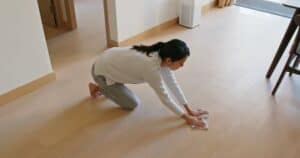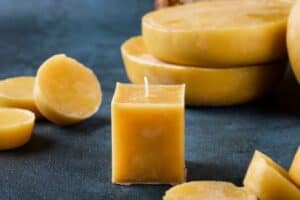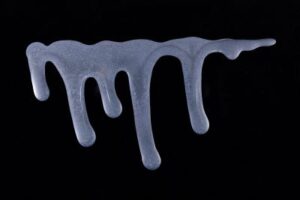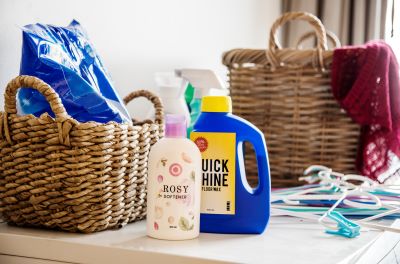Removing Wax From Hardwood Floors
Have you ever had a candle spill hot wax all over your hardwood floors? Maybe the cat knocked it off a table or the kids were throwing a ball in the house and the ball hit your wax warmer.
So, how do you get wax off hardwood flooring? Have no fear, there are lots of ways to get the wax off your flooring, involving heat and/or ice. One of the easiest ways is to heave up the wax as much as possible using a hairdryer before you scrape the melted wax off the flooring.
In the article below, we will go over several different ways to remove spilled wax from wood floors that have been tried and tested.

Removing Wax With Heat
- Scrape up as much melted wax as possible using a dull blade or scraper.
- Apply heat with a hairdryer, keeping about 12″ away, while simultaneously scraping any remaining residue with a dull blade or plastic card (ex: old gift/credit card). The heat will soften the wax, making it easier to remove.
- Use a damp lint-free cloth (ex: old t-shirt or towel) to remove any remaining residue and buff the floor.
Alternative Heat Method
If you don’t have a hairdryer handy, another way to heat the wax is by using an iron. As in the other heat method, scrape up as much of the wax as you can.
Place a paper bag or old towel that you don’t mind throwing away over the spill. Use an iron on low to make passes over the bag or towel and slowly heat the wax. You don’t want to leave the iron sitting in one place as this could damage your floors.
As the wax melts, it will absorb into the bag or towel. If any wax is left, just repeat until all the wax has been absorbed.
Removing Wax With Ice
- Hold ice in place on the spilled wax for 30 seconds, even if the wax is already cool. You may need to keep the ice on the wax longer if it is a fresh spill and the wax is still warm.
- Use a credit card or other plastic scraper to scrape at the frozen wax. If it is cold enough, the wax should pop free of the floor allowing you to pick it up.
- If some of the wax isn’t coming up, add ice to it again and repeat.
- Use a clean cloth to dry the area of any water from melted ice cubes.
After using any of the above methods, you may want to use furniture wax to buff the area and remove any remaining residue.
What Is Candle Wax Made Of?
Paraffin wax is made from petroleum and has been used for candle making for centuries. It comes in many different grades of hardness.
This generally affects burn time and its relationship to atmospheric conditions (humidity, temperature). Paraffin wax melts at between 140-150 degrees Fahrenheit.
It is also the most common type of wax on household floors because it’s inexpensive, easy to work with, and can be found anywhere.
Paraffin wax candles are usually only 10%-20% actual paraffin wax. The other ingredients (80%-90%) are deodorants, detergents, etc.
This helps make the artificial paraffin wax into a candle by adding colorant & perfumes to give it a nice smell and coincidentally make it produce more soot during burning.
One of the most common problems with paraffin wax is that many people buy a so-called “plain” wax candle thinking they are getting a better product for their money, when in fact all they’re doing is paying extra for an inferior product.
This is because the majority of the candle is not even wax – it is made of artificial ingredients added to make them cheaper to produce while charging double & triple what a paraffin wax candle would be charged.
Other Types Of Candle Wax
Wax is the generic term for a solid mixture of organic compounds found in plants and animals.
The word ‘wax’ may refer to either beeswax or other types like spermaceti (from whales), carnauba (palm tree), bayberry (fruit-bearing shrubs or small trees), or our favorite; paraffin which is made from petroleum.
There are hundreds of kinds of waxes. Most waxy substances are solids at room temperature, but some are liquids even though they have high molecular weights; examples include fatty acids, many manufactured lubricants, and mineral oil.

Floor Wax
Let’s consider another scenario. Rather than candle wax, what would you do if you are going to refinish your hardwood floors and need to remove the old buildup of floor wax?
Surely ice or a hairdryer aren’t going to do the job? This is a far more time-consuming and labor-intensive job than removing some spilled candle wax, but it is possible to do it yourself.
Why Do People Wax Floors?
The primary purpose of floor wax is to enhance the appearance and durability of wood floors. Oil is great for floors, but it can be applied too thickly causing drag when you walk on the surface or excessively spotted by impurities called sediments.
This gets trapped in the film causing it to pit or degrade faster than normal. Floor wax is an oil-based substance with added chemicals like solvents, resin modifiers, and wetting agents that make it more viscous, which makes it harder for dirt and dust particles to push through the surface causing blemishes on your floor.
Some floor waxes have added plasticizers that soften the film so that it doesn’t crack or harden with age when exposed to sunlight or rapid temperature changes. Plasticizers are also responsible for making the wax more water-resistant.
Why Would You Want To Remove Floor Wax?
Not everyone has the money to regularly resurface their floors, so waxing provides a cheaper option for covering up minor blemishes.
If you are trying to achieve that high-gloss look, then waxing your floor is better than leaving it bare because it gives you less chance of having the finish scratch off with heavy traffic. Over time, the coats of wax build up, making it difficult to clean or resurface the floors.
When this happens, the best thing to do is remove the old floor wax to provide a nice, clean slate for a new coat of wax. Chemically stripping old coatings can be dangerous if they contain lead or asbestos, but most healthy solvent-based strippers won’t harm you if directions on their labels are followed.
They do however produce nasty fumes and should never be heated or they might explode. Meanwhile, water-based strippers are less effective at removing wax but safer to use since there is no risk of fire.
How to Remove Floor Wax from Hardwood Floors
- The first step is to scrape as much of the excess wax off with a putty knife as possible, then dilute it with paint thinner or mineral spirits until it becomes thin enough that you can wipe it away.
- Once this has been done, put on safety gear (goggles and gloves) and pour acetone into a bucket – one cup per gallon of water. Using a clean rag, wipe down your floors to remove all traces of floor finish. Allow them to dry overnight.
- You’ll need to mix up some floor wax stripper next: one cup of liquid detergent (Tide works well), two cups of trisodium phosphate (available at any hardware store), and two gallons of hot water. Dip your mop into the solution to coat it, then start in the corner farthest away from an exit or open window. Spread this mixture liberally over about 6 square feet of flooring at a time, scrubbing with your mop. Allow this cleaning solution to sit for no more than five minutes before you wipe it up with a clean rag. You can use the same rag until it is completely soiled. Don’t leave any puddles or streaks behind because they will dry sticky.
- The final step is to mix up a solution of trisodium phosphates (TSP) substitute such as borax (follow directions on container) and warm water (1/2 cup per gallon). Mop down your hardwood floors with this solution using a new bucket & fresh mop for each 6 square foot area, then rinse it thoroughly with warm water and mop again to remove all traces of the solution.
- Finally, dry your floor immediately with a new mop or a squeegee/dry mop system. You want to get it completely dry within an hour because any remaining moisture will encourage stains & discoloration later on.
Voila! You’re done and have clean floors that are ready for a new coat of wax if you so desire.
How To Avoid Floor Wax Spills
When waxing hardwood floors, the most important thing to remember is not to pour a large amount of wax into one spot. You can distribute it throughout the floor by using a paintbrush or lint-free cloth and applying it in small amounts at one time.
The first step to cleaning spilled wax off of your hardwood floor is getting as much as you can off right away before it sets. If any has already set, use either hot water or wood cleaner along with an old rag to wipe up what you can and then dry immediately so there isn’t any standing water that could warp your hardwood floors.

How Long Should You Wait Before Applying More Wax?
Some areas of your floor may need more than one coat of wax. Once your floor dries, you can apply another coat in 24 hours if it’s needed.
Heavily worn areas such as doorways and hallways should be rewaxed more often than other rooms.
In Conclusion
Whether you are cleaning up spilled candle wax or removing layers of old floor wax, there are several options to help you get the job done. A simple change in temperature by heating or freezing candle wax makes it relatively easy to remove from your flooring.
While removing floor wax is a much bigger job, it is still something you can manage to do without calling in a professional. It is very important to wear the correct safety gear when dealing with chemicals to avoid burning your skin or inhaling toxic fumes.
These tips should help you use DIY solutions to keep your hardwood floors looking beautiful for years to come.

